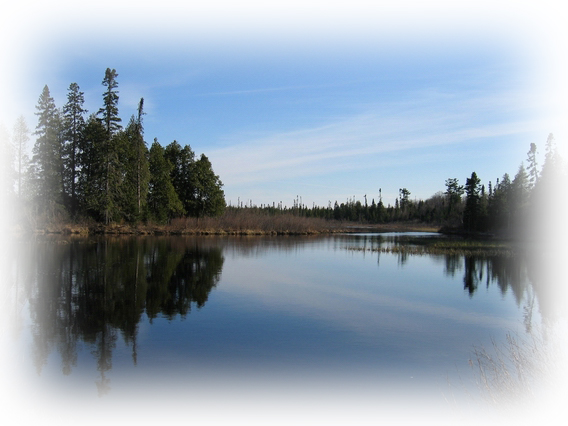
Acid Mine Drainage (AMD) in a stream - MPCA
Northern Minnesota groups file lawsuit against MDNR decision to not require an Environmental Impact Statement (EIS) for Northshore Mining expansion
To view in a PDF click HERE
Duluth, Minnesota --- June, 17th, 2015 --- Save Our Sky Blue Waters, Save Lake Superior Association, and Wetlands Action Group have filed notice to appeal the Minnesota Department of Natural Resources (DNR) decision to deny an Environmental Impact Statement (EIS) for the Northshore Mining Company Progression of the Ultimate Pit Limit located in St. Louis County, Minnesota.
The groups believe that the DNR failed to take the required “hard look” at the proposed Project because the Environmental Assessment Worksheet (EAW) indicates there may be potential for significant environmental effects.
By expanding taconite operations at its Babbitt, Minnesota site, Northshore will uncover a layer of sulfide ores, thus exposing them to the environment (air and water) and allowing for pollution that includes sulfates, heavy metal leaching and potential acid mine drainage (AMD).
This process has previously occurred when sulfide ores were exposed at the former LTV taconite mine’s Dunka Pit. The removal and stockpiling of the sulfide ores at the Dunka site has already caused significant and long standing environmental harm. After 50 years, the Dunka Pit sulfide-bearing waste rock continues to leach heavy metals into Bob Bay of Birch Lake / Kawishiwi River, which flows into the Boundary Waters.
“Before we let the mining companies open up another sulfide ore body in Minnesota, we should make sure they can clean up the mess from the decades-old, ongoing pollution at the Dunka Mine site. This project will destroy wetlands, and could degrade streams, rivers and lakes. Our waters are too valuable to be traded away for short term mining company profits.” said Bob Tammen - Wetlands Action Group.
Of further concern are the impacts to Northshore’s Milepost 7 tailings basin, which is located just upstream of Lake Superior and the North Shore communities of Beaver Bay and Silver Bay, where the additional taconite tailings would be stored (the sulfide bearing rock would be stockpiled at the mine site). Decades ago, the Reserve Mining Company was forced to stop dumping its tailings into Lake Superior--and contaminating Duluth's and surrounding communities’ water supplies with asbestos-like fibers. The DNR initially opposed Milepost 7 as the preferred on-land tailings disposal site because of safety concerns. The Company prevailed in court, however, and the Milepost 7 location was eventually chosen and completed in 1980.
The recent Canadian mine disaster at the Mount Polley mine site is an example of the potential for catastrophic tailings basin failures. Like the Mount Polley tailings dam, Milepost 7 is located on potentially unstable glacial foundation materials. In addition, an Independent Expert Engineering Investigation and Review Panel released a report on Mount Polley in January 2015 that calls for an end to wet tailings storage for mine waste. As Milepost 7 is now situated, any break in the wet mine tailings basin dike would send the dangerous mineral fiber laden contents directly downstream into Lake Superior and nearby communities.
“We can’t just continue to permit these mining projects without considering whether they are safe for the impacted communities. Dangerous asbestos-like mineral fibers from the East range threaten human health. We are concerned about the contamination of drinking water and consumable fish in Lake Superior. Northshore Mining’s proposed expansion must be fully analyzed in an EIS.” said Le Lind - Save Lake Superior Association.
Need for an Environmental Impact Statement (EIS) - The Environmental Assessment Worksheet (EAW) completed for the Northshore expansion does not present adequate information on the potential treatment of the sulfides that will be exposed, and the subsequent continued load of sulfates, mercury and methylmercury into the environment. Nor does the EAW adequately address impacts to the waters and wetlands from the project to the Partridge River and Dunka River watersheds.
The DNR is thus remiss in failing to address and predict potential significant impacts to the environment of the kind and scope that could result from the proposed expansion of Northshore Mining’s Peter Mitchell mine site, and the kinds of mitigation and financial assurance that would be required ahead of any potential environmental damage. For example, it is known that the heavy metal leaching from exposed sulfide ores can last for hundreds to thousands of years, requiring near-perpetual treatment.
In addition, the Northshore Mine site is situated on the Laurentian Continental Divide, straddling two watersheds. After pit closure, all discharges will be diverted into the Rainy River basin, which includes Birch Lake and the Kawishiwi River. This is a significant environmental impact to the Partridge River and will undoubtedly result in negative impacts to the St. Louis River and the Lake Superior watershed. Removing thousands of acres from the Lake Superior watershed results in a large diversion of water out of the Lake Superior Basin, and is contrary to the Great Lakes Basin Compact.
Both the Rainy River and Lake Superior watersheds have the potential to have significant, adverse and long lasting impacts from Northshore Mining’s proposed taconite mine expansion, both are waterways of international importance.
Being that the impacted watersheds lie within Native American Tribal Ceded Territory, pollution and degradation of food sources such as wild rice, and water resources - is also an environmental justice issue.
“The Minnesota DNR needs to take a hard look at the significant issues involved in Northshore Mining’s proposed expansion, and cannot continue to sweep the environmental impacts of mining activities under the proverbial rug for future generations to deal with. The quality of the environment, the wildlife, the fish, and the water of this area directly affects the health of the human population living here.” said Lori Andresen - Save Our Sky Blue Waters
The groups are seeking a reversal of the DNR's negative need declaration for an EIS on the proposed Northshore Mining expansion. The groups are asking the Court of Appeals to reverse the MDNR decision because the administrative record establishes that the MDNR failed to take a "hard look" at the relevant environmental issues, made the decision based upon an error of law, the decision was arbitrary and capricious, and substantial evidence does not support the decision.
The northern organizations maintain that an EIS is required, due to the type, extent, irreversible, and cumulative potential environmental effects from the proposed Northshore Mine project.
James P Peters
Attorney for Petitioners
Glenwood, Minnesota
(320) 634-3778
jim@peterslawfirm.us
Bob Tammen
Soudan, Minnesota
(218) 343-6047
bobtammen@frontiernet.net
###

Click Here for Larger Image of Mile Post 7 located near Lake Superior


